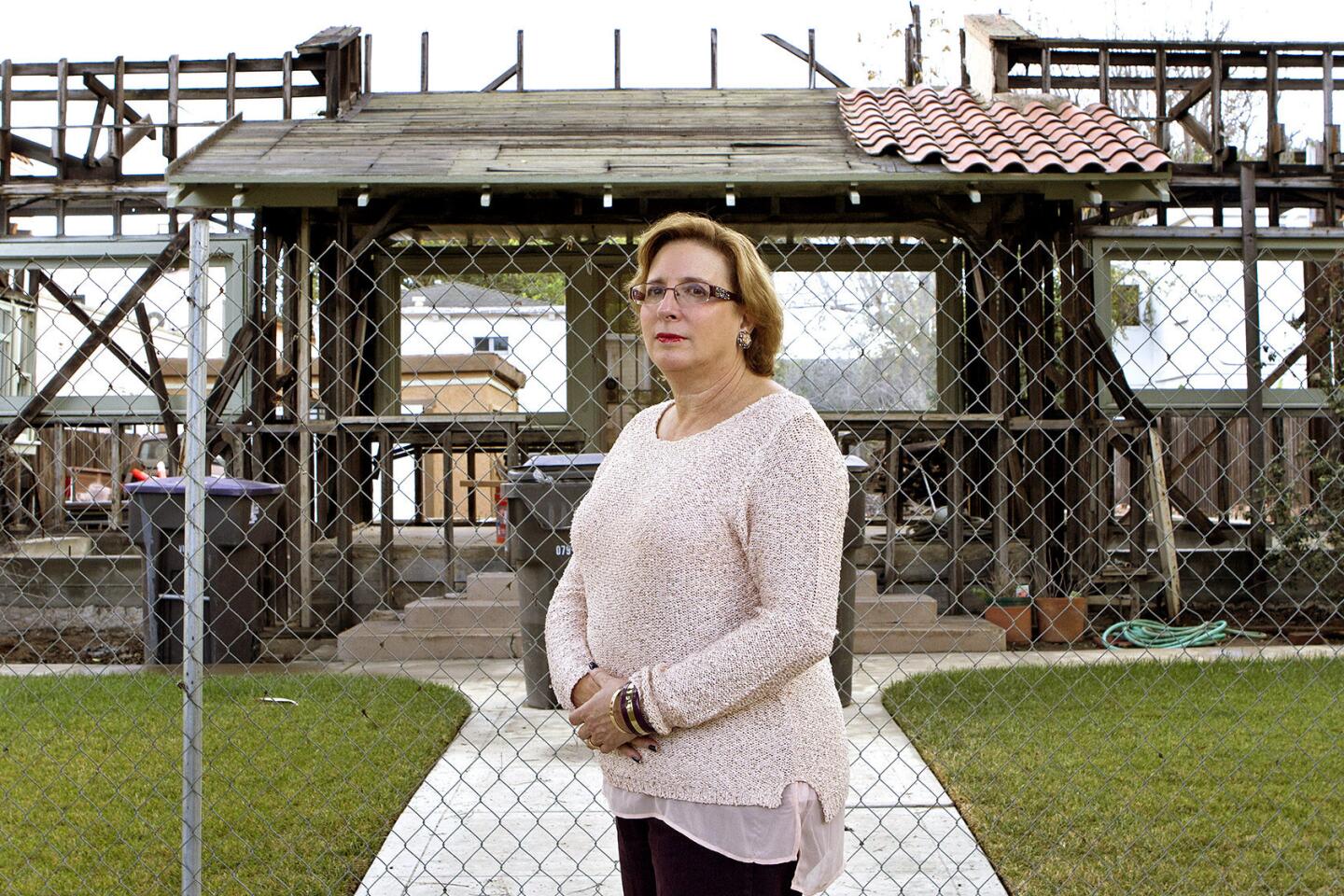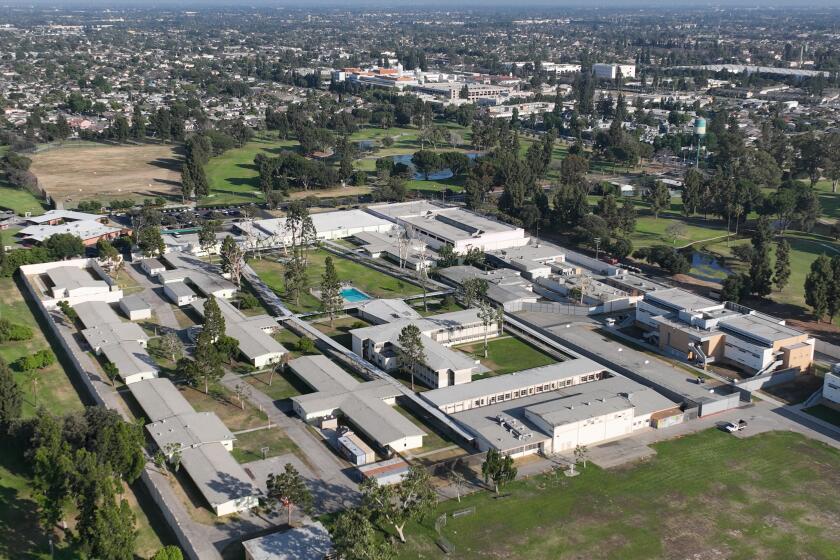Long an empty shell, vintage Long Beach home has plans for the future
- Share via
It’s not that the house has good bones or bad bones, but that it has been nothing but bones — for nearly nine years.
Surrounded by a chain-link fence, decried by the neighbors and gawked at by passersby, the skeletal remains of 2810 E. 1st St. in Long Beach’s Bluff Park neighborhood have been in that sorry state since December 2005, when a new owner took the structure down to its framing studs.
In many neighborhoods, the house’s near-demolition might not have sparked much of a stir. But it did in Bluff Park, a stately enclave of century-old Craftsman bungalows and Spanish Colonial Revivals that was designated a historic district in 1982.
There, as in scores of other California historic districts, significant exterior alterations are subject to local government review — and often the vigilant gaze of neighbors with deep roots and strong civic ties. Factor in a newcomer accused of exceeding the scope of his construction permits and what set out to be a modest renovation morphed into a case study of the risks in running afoul of historic district building codes.
“It was a terrible experience,” said Mohammad Movahedi, who bought the house in 2004 for his family and sold it eight years later at a $319,000 loss, never spending a night there. “I am trying to move on with my life and want nothing to do with it anymore.”
Neighbors who have lived with the unsightly shell all these years aren’t much happier. Only recently has a new owner begun work to replicate the 1,920-square-foot, Mission Revival bungalow that had stood since 1921.
“It is just so sad that this has gone on for so long,” said Debbie Malumed, a physician who lives across the street with her husband Alan Lowenthal, a Democratic congressman.
::
Named for a park overlooking Long Beach Harbor and the Queen Mary, the neighborhood grew up in a post-World War I real estate boom fueled by the city’s robust oil industry. Bankers, silent film stars from nearby Balboa Studios and others among the well-to-do lived in the area, some in mansions on Ocean Boulevard.
The single-story, three-bedroom house at 2810 E. 1st St. was modest compared to many of those in the neighborhood. Not a landmark in its own right, it was the kind of house that preservationists say contributes to the fabric and character of a neighborhood.
Since the 1960s, Southern Californians have created a patchwork of historic designations and districts to protect older and original homes and other structures, including grand estates, doughnut shops, movie theaters, high-rise apartments and office buildings.
Ken Breisch, founder of USC’s graduate program in historic preservation, said the effort “helps to preserve not just the historical character of a neighborhood, but the quality of life.” Although the number of historic districts is growing, their effect varies based on local ordinances, he said.
Some communities have been effective and some have made little or no effort, according to the Los Angeles Conservancy’s “2014 Preservation Report Card.” The nonprofit group gave an F to 51 cities and all unincorporated areas in the county.
Long Beach, which has 17 historic districts including Bluff Park, received an A.
Linda Dishman, the conservancy’s executive director, said districts aren’t trying to prevent remodeling.
“No one is saying you can’t have the master bedroom of your dreams or that great room that links the family room and the kitchen,” she said. “It’s all about how the change is done to the house.”
::
The house at 2810 E. 1st. St. had several owners before Frank and Myra Linehan bought it in 1960. With a stucco exterior and a Craftsman interior, it featured leaded glass, brass light switch plates and distinctive Catalina tiles, said their son Randolph Linehan, a Rancho Mirage attorney.
“The gentleman who purchased it from my dear mother said he really wanted to live in this kind of a house and he was only interested in adding on to the back of the house,” Linehan said. “My mom said ‘Wonderful,’ The next thing we knew, he’d torn the dang thing down.”
Mohammad Movahedi and his wife, Negar Derakhshani, bought the house in January 2004 for $725,000, and got permits for plumbing and electrical upgrades, a new roof, interior renovation and a 523-square-foot addition, records show. He said he also had city permission to redo the stucco exterior.
“My intention was to respect its historical heritage,” said Movahedi, who grew up in Iran in a 250-year-old house that was in his family for five generations.
Then in late 2005, Movahedi’s contractors found extensive termite and water damage, and other structural problems that posed health and safety issues and required major repair, he said in public records.
When city officials halted work in January 2006, the house had been stripped of its roof, walls and flooring — nearly everything but its framing and a few windows. Then began an often acrimonious round robin involving Movahedi, city officials, elected leaders, preservation advocates and a neighborhood association.
For six years, as the weeds grew and the house’s remains stood bare against the weather, Movahedi and his wife tangled with the city. They hired lawyers and architects and engineers as they sought to rebuild. Finally, in 2012, they filed a lawsuit accusing the city and its Cultural Heritage Commission of abusing code enforcement powers, violating their due process rights and capriciously changing the ground rules.
Movahedi said he and his wife fell in love with the neighborhood while renting an apartment there. But the couple, both U.S. citizens, were treated like unwelcome outsiders because of their Iranian heritage, he said.
Long Beach historian Stan Poe, an ex-officio member of the city’s Cultural Heritage Commission, denied that.
“He was told by everybody that he couldn’t tear it down, and he proceeded to tear it down,” Poe said.
In August 2013, a federal judge ruled for the city. By then, the couple had sold the house for $406,000, a 40% loss. Movahedi said he had spent more than $1 million on the project. The last straw was the city’s demand for a $65,000 environmental impact review that offered no assurances, he said.
“We didn’t have the resources and we were psychologically drained,” said Movahedi, a biochemist who manages his wife’s Orange County dental practice. “We had small children and we needed a home for them, and all the while we are paying all the costs for that house.”
::
Over time, neighbors dubbed it the “stick house” and the “infamous frame house.” They have long been upset and frustrated, not just with Movahedi but also with city officials, elected leaders and prosecutors for not taking stronger action, said Debbie Malumed, who sees the house from her front windows.
At long last, progress is being made.
The new owner, real estate investor Alan Schwendener, took the step Movahedi wouldn’t, paying about $70,000 for an environmental impact review that helped win approval for the project. He has poured a new foundation. The new house will mirror the original’s design, footprint and facade, he said.
“It was a pretty simple house and we’re keeping it pretty simple,” he said.
twitter: @christensenLAT
More to Read
Sign up for Essential California
The most important California stories and recommendations in your inbox every morning.
You may occasionally receive promotional content from the Los Angeles Times.
















